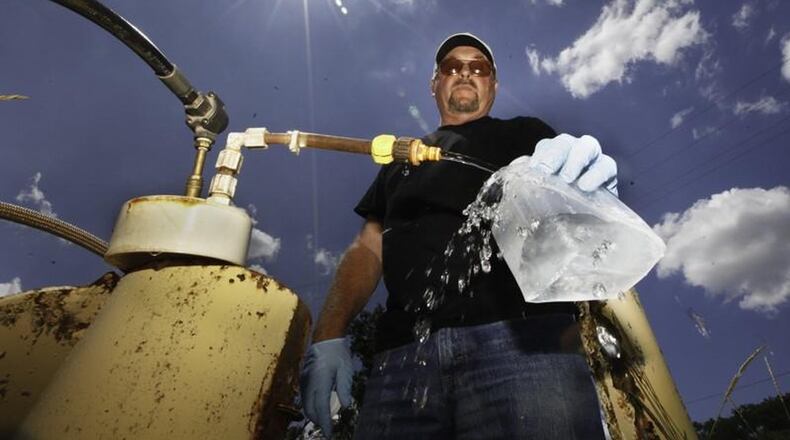The report, titled “Dayton Water Quality and Infrastructure Review,” and commissioned by a group made up of local business and government leaders, also urges the region to invest in water infrastructure.
“It’s good news,” U.S. Rep. Mike Turner, R-Dayton, said of the report in an interview Tuesday. “That was what was important — what we needed as a community was an independent group to tell us what is our water quality, what infrastructure needs do we have.”
Turner formed the 13-member water quality panel — made up of local government and business leaders — in 2019. Members include representatives from the city of Dayton, Montgomery County and the city of Trotwood. The group hired LimnoTech, a Michigan-based environmental engineering consulting firm, to conduct the study.
The study recommends “extensive monitoring” for the chemicals, known as per- and polyfluoroalkyl substances or PFAS. The group of toxins is the most immediate threat to the Buried Valley Aquifer, where the majority of communities on the region get their drinking water, the report said.
“At present, the greatest risk to the water quality of the (aquifer) is the impacts from PFAS substances,” the report said. “PFAS has been detected in the raw and finished water of Dayton’s Ottawa Water Treatment Plant at concentrations below 70 ppt (parts per trillion), the current EPA health advisory limit. The city’s Mad River wellfield is located directly adjacent to and downgradient from Wright Patterson Air Force Base (WPAFB) operations.”
In May, Dayton sued Wright-Patterson Air Force Base and the U.S. Department of Defense in federal court for allegedly failing to stop water contaminants from entering a source of the city’s drinking water. The base and DoD denied the city’s claim.
In February 2018, the base informed the Ohio Environmental Protection Agency that test results “pointed to” Dayton’s firefighting training center on McFadden Avenue as a potential source of PFAS contamination, the report said. As a result, OEPA ordered the city to track potential contamination from the center.
According to the report, the city’s facility used Class B AFFF (aqueous film forming foam) containing PFAS chemicals.
The base, which says it no longer uses PFAS chemicals in firefighting foam, has been studying PFAS contamination in its vicinity since 2016, after sampling by the state in 2014 and 2015 “detected high levels in the groundwater in several areas,” the report notes.
The report also echoed a 2012 Water Efficiency Master Plan recommendation to build a $64 million pump station at the Greater Moraine Water System to boost resiliency.
Water quality study also calls for the creation of “standby power” at city wellfields to provide “a minimum level of service.”
Dayton’s primary source of drinking water comes from the Buried Valley Aquifer, where two city water treatment centers deliver water through mains to some 400,000 local customers.
The report notes that the aquifer is one of the largest in the nation, with more than 100 large capacity, gravel-packed production wells, each pumping 1 million to 4 million gallons of water a day.
Tom Raga, vice president, external relations at electric utility AES Ohio, is chairman of the water panel. The 65-page water quality report does not identify problem areas, he said.
“But the mission of the report was to define areas that would be helpful to the city and the county on what they would do over the long term, Raga said, referring the Dayton and Montgomery County. “It (the report) said, ‘Good today. Here’s how you stay at that level and improve going forward.’”
Several recent events led to Turner forming the water panel. Chief among those: The February 2013 break of a 36-inch water main parallel to the Great Miami River. Ultimately lost in that late-winter break were about 150 million gallons of drinking water, leading to a countywide boil advisory affecting 400,000 people for more than 40 hours. Schools and businesses closed.
The Memorial Day tornadoes of 2019, and the break of another water main, a 48-inch main in August 2020 near the Ottawa Water Treatment Plant and continued concerns about the presence of PFAS chemicals also led to the panel’s creation.
“After multiple events in 2019 threatened our community’s infrastructure, I created the Dayton Water User Committee to review the water quality in our region,” Turner said in a statement. “They confirmed that our water is safe to drink. Daytonians deserve this confirmation and I am thankful for the city of Dayton and Montgomery County for prioritizing this urgent study.”
The extent of the presence of PFAS in local water “is still playing out,” the report says.
Last month, Montgomery County’s drinking water was found to have low levels of a group of contaminants that have been linked to cancer and birth defects.
However, those results may be misleading because Ohio’s health advisory for the toxins, dubbed “forever chemicals,” is one of the highest in the country, a local ground water expert told the Dayton Daily News at the time.
PFAS are dubbed “forever chemicals” because of their indestructible nature.
“Overall, the water quality in the BVA is very good. This robust water resource is clearly valued by the community and the city,” the report said.
“We are pleased to read the final report from the Dayton Water Panel showing that our region is in good standing,” Matt Hilliard, director of Montgomery County environmental services, said in an email. “We will continue to make water infrastructure investments around the county and will continue to test our distribution sites for PFAS.”
The Air Force is working with with communities to ensure that harmful chemicals remain below regulatory thresholds, a spokeswoman for Wright-Patterson said.
“Four years of sampling data and technical assessments from 2015 to 2020 show PFOS/PFOA concentrations at a steady state with no indication of higher concentrations in groundwater migrating off-base,” a base spokeswoman said in a statement. “Furthermore, Dayton and WPAFB finished drinking water is below the EPA lifetime health advisory.”
Dayton city officials could not be reached for comment.
About the Author

